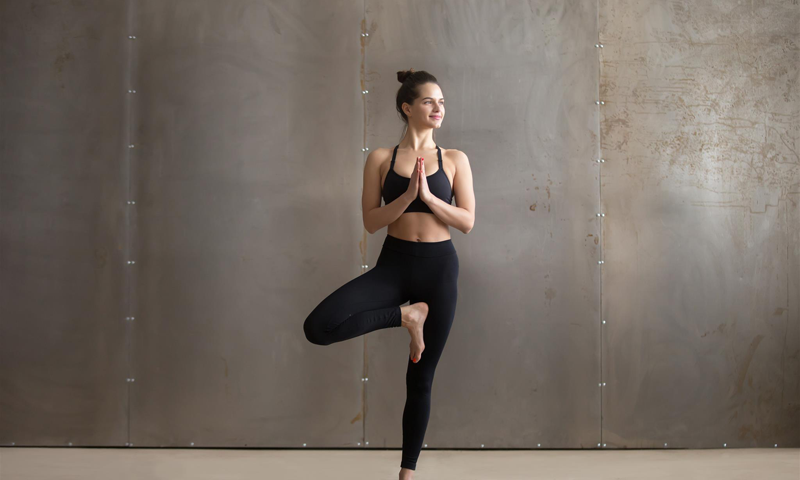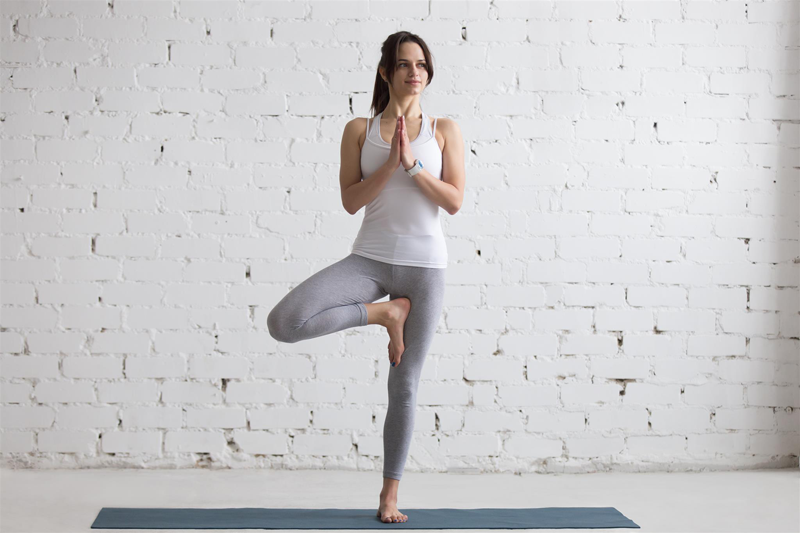
How to do Lotus pose in yoga
21st June 2018
How to do Child’s pose in yoga
22nd June 2018How to do tree pose in yoga

The tree pose is also known as Vrksasana. It is called tree pose as you are rooting your standing foot into the ground. The point is to feel a sense of stillness – both in body and mind. This will not happen when you first begin but with practise you will enjoy stability.
Remember, this yoga pose exists to show us how hard it is to stand on one leg. It also illuminates just how open your hips are. The aim is to stand on one leg with your knee pointing straight out to the side and your arms high in the air. This is the aim. Your body may not want to cooperate at first.
The benefits of this pose
You are practising this pose to establish strength and balance. You will become steady and grounded, eventually. The point of doing this pose is to learn this strength and balance, meaning you may not have this at first. Yoga is about the positive movement towards something to which we aspire. It is about accepting that, at first, we may wobble, and we may not feel strong or centred.
You are practising this pose to understand your alignment.
Instructions
- Stand in mountain pose.
- Shift your weight onto your right foot.
- Bend your left knee, moving it upwards towards your chest.
- Keep your spine long and reach down to clasp the left ankle
- Place the foot on the inner right thigh.
- Lengthen your tailbone to the floor and stand tall.
- Bring your gaze directly in front of you. In other words, lift your chin up and look straight ahead – try to avoid looking at your standing leg wondering why it is on its own in meeting the floor.
- Press your left foot into the inner right thigh and put your effort into maintaining the plumb line of your body straight – or, in other words, keep your hips straight. This pose is all about maintaining this midline.
- When in pose take five to ten deep breaths – rooting into the foot with each exhalation.
- Replace the foot to the floor and repeat with the other leg. You will likely find one leg easier than the other.

Tips
There are some points of posture to avoid, helping you towards your perfection. Keep your standing foot angled straight forward and keep the foot off the knee – it should be on the thigh or calf.
Think of balance here as a verb. It is something you are doing, rather than an act. You will need to put continual effort into maintaining this balance. You are going to have to focus and respond to the changes in your body that might make you feel unstable.
Modifications and Variations
You can start by lying on the floor and prepare with Supta Vrksasana. Flex your feet as if they are pressing up against the wall – you might notice that you arch your lower back too much, so you need to draw your hips up to your ribs to remove this arch. If you engage your core muscles this will happen naturally, and your back will flatten. Put your hands on your hips and draw one foot up to your inner thigh. Your aim is to maintain this flat position of your back – but you may find your hip tipping to one side. This is part of the exploration of this pose.
It is then a good idea to stand up and work with Tadasana, or Mountain Pose. This will help you align your hips and to get a solid basis when lifting your arms. This alignment is what you need to maintain when you stand on one leg. You do not want to twist to one side or another. But, be aware when you lift a leg for the first time you will find yourself swinging one way or the other, or that you will lose balance. The aim is to move towards stable practise – as if both your legs are still on the floor.
When positioning your body in tree pose the point is to understand your hip-opening capacity. If you can’t open your hips particularly wide at first, then your knee needs to point at an angle that gives you stability and maintains the Mountain alignment. Eventually, with practise, you will be able to open out your hips and point the knee out at a right angle.
To perfect the pose
This is a pose that helps you to inquire into the truth of your body. The perfection of this pose is an adventure into understanding your alignment at this present moment. The truth may be that you need to push your knee slightly forward to maintain alignment. Equally, you may need to engage the abdomen with more strength in order to prevent an arch to the back.
In short, the perfection of the tree pose itself may not be the point. You may not aspire to the perfection of the pose of your yoga teacher. Instead, your perfection can come from the practice of satya, the practice of truthfulness. Whatever your alignment is at this time is what is true. Balancing on one leg is challenging. Therefore, your body may only be able to attain a certain degree of perfection at one point. So, explore what your body can do.
Yoga is not really about the practise of poses. Being able to hold extreme poses makes yoga competitive, which it should never be. Your perfection should be different to the perfection of the person next to you. This is because yoga is a means of practising life and here you are practising exploring your body and what it takes for it to feel balanced. With this enquiry you will eventually be able to point your knee to the side.

